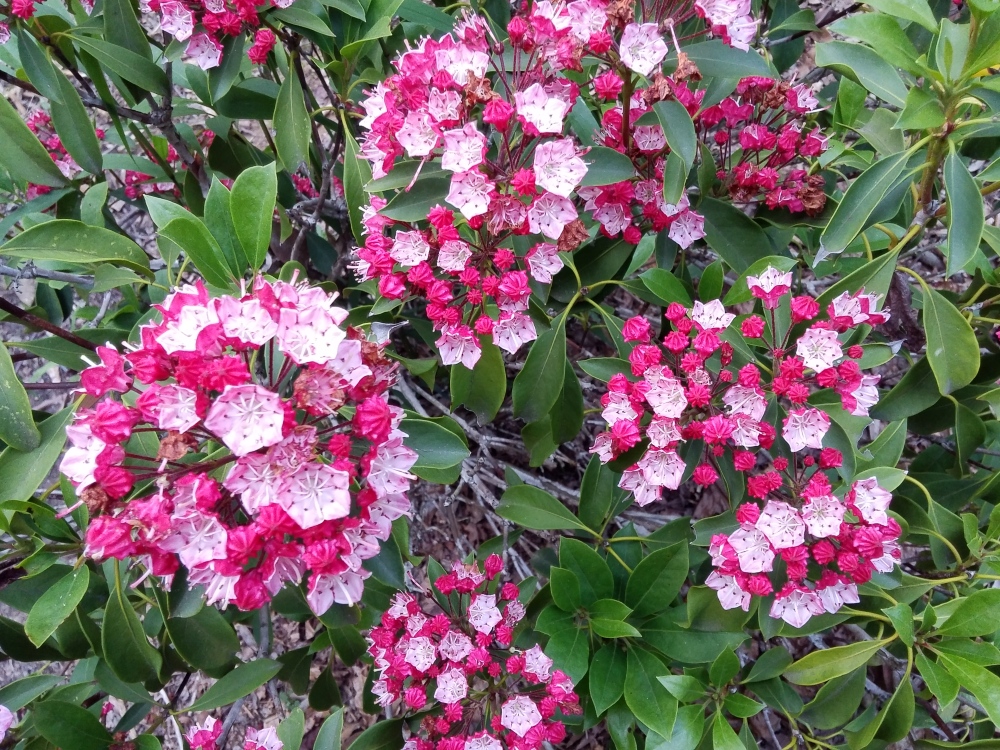Perhaps the wildness of this garden has gone a step too far. Yes, Japanese beetle populations are mostly held in check by birds, and mosquitoes are minimized in the rear garden by dragonflies that perch on tall irises and sweetflags bordering the koi pond. The gardener will argue against the spraying of poisons, figuring that nature will find a balance, but he mistakenly assumes that the good guys will win in the end. Some days this works out, others, not so much. Today is one of the other days.
As I walked from the house to the rear garden I admired the Mountain laurel (Kalmia latifolia, above) and a red flowered peony, which, unfortunately, opened its flowers on the first ninety degree day and already the edges are browning. I stopped to pluck a few weeds, intent on the task, then was startled and stumbled to avoid a long black snake that was slowly moving across the asphalt driveway. Surprisingly, the snake barely noticed my presence, and as I went back for a second look it was clearly in distress. When I retraced my steps back to the house an hour later, the snake was gone, to my relief.

This afternoon, Northern Brown water snakes that inhabit the koi pond are not seen, but I prefer to know where they are, rather than suspecting that they might lurk from under any boulder at the pond’s edge. A turtle fled into the water as I approached, and again this afternoon the koi are reluctant to surface, a sign, I’m certain, that a predator has been sighted. But, which one? Hawks, herons, snakes, or four legged beasts? All are sighted frequently.

I meander to the far side of the pond, through mud to the lower garden where, even after several hot and dry days, there is standing water in places. Grasses have become tangled in Japanese (Iris ensata) and Blue flag (Iris versicolor, above) irises in the wettest spots, but today is too damp to work on this without making a mess of things. Maybe next week.
The earliest of the irises are flowering, and to the drier side of this low garden, the marvelous ‘Magician’ deutzia (Deutzia x hybrida ‘Magicien’, above) is in bloom. This shrub is unremarkable for much of the year, but for several weeks beginning in late May there is not a finer flower. Nearby, the white flowered ‘Chardonnay Pearls’ (Deutzia gracilis ‘Duncan’, below) is splendid, and with yellow foliage that scorches only in the hottest, driest summers, it rates a close second to ‘Magician’.
With repeated rainfall in recent weeks, the dry shade side garden is not so dry. I stop to sit for a moment on the log stools fashioned from a swamp red maple that toppled in a December ice storm. Instantly, my legs are spotted with tiny Tiger mosquitoes. Here, there are no dragonflies to limit the population, so I move on, completing the loop to the driveway to verify that the black snake has found the strength to move to safety.
As I remove my mud covered shoes before going indoors I pluck two small ticks, the first that I’ve noticed this spring. Later, my wife complains that I’ve opened the door to let mosquitoes in. Indoors is no place for such wildness. She promptly swats the small insects.

Do you have any advice for growing “Chardonnay Pearls”? Mine is struggling, in a mixed border where other deutzia have flourished. It is getting more sun than the others, though.
Of two planted, one does poorly in damp ground. The other is in mostly full sun with part shade in late afternoon. I often find that plants with yellow foliage burn in full sun, but there are so many varying conditions that I hesitate to diagnose problems unless the cause is obvious.
Thanks! I do have clay soil but planted my Chardonnay Pearls slightly elevated with soil amendments around it. Maybe it’s still not getting enough drainage, although it’s next to an English rose that is flourishing.